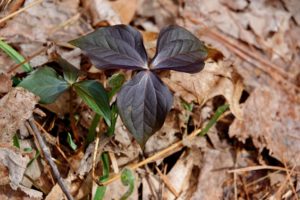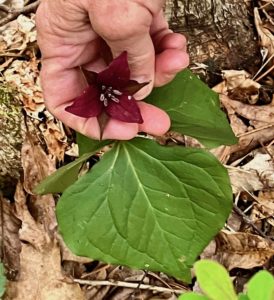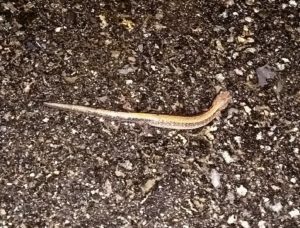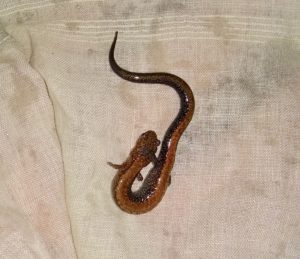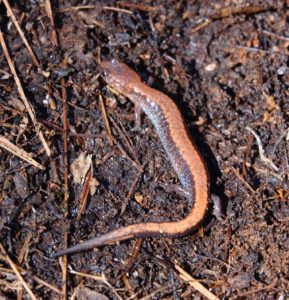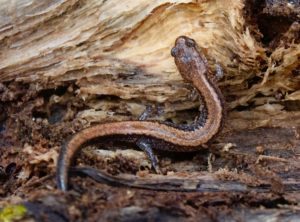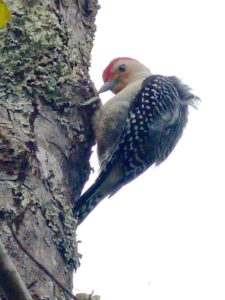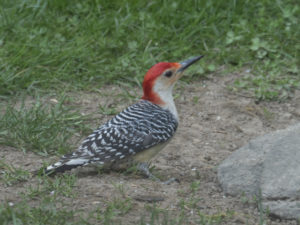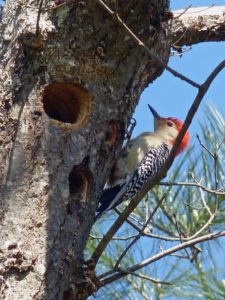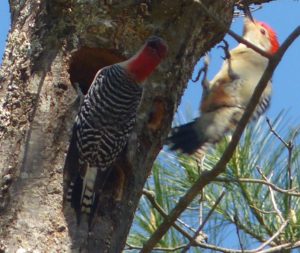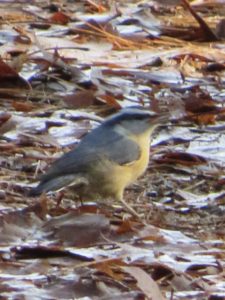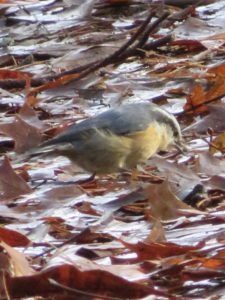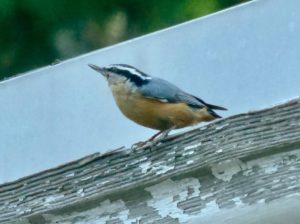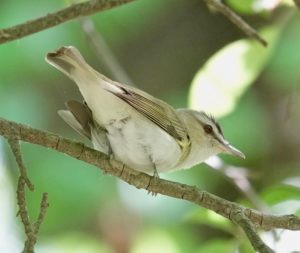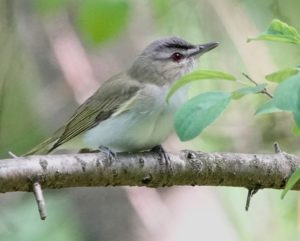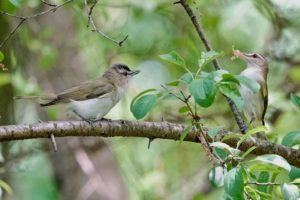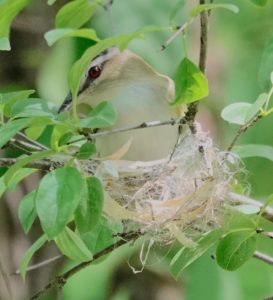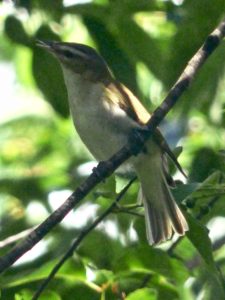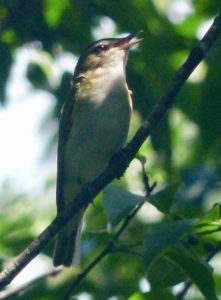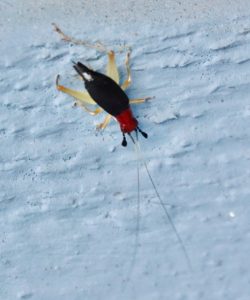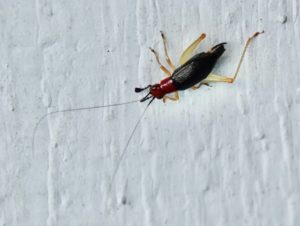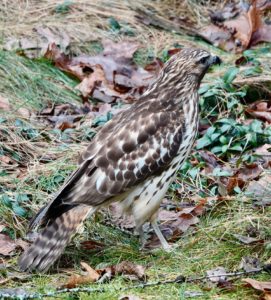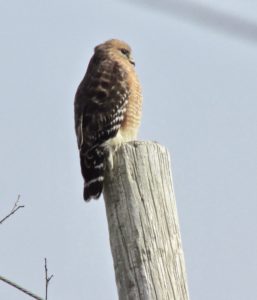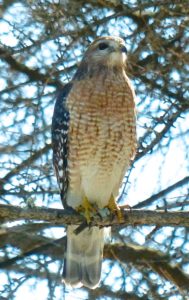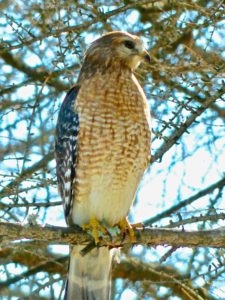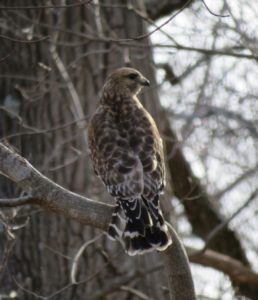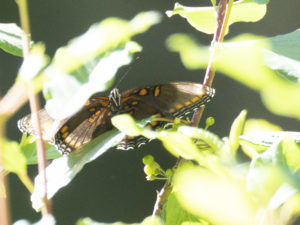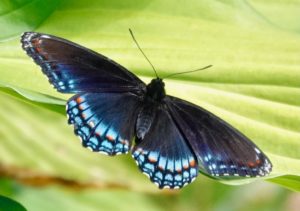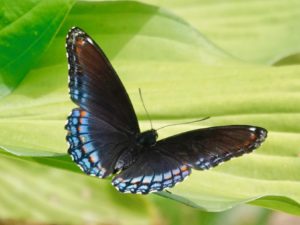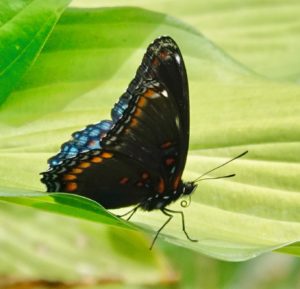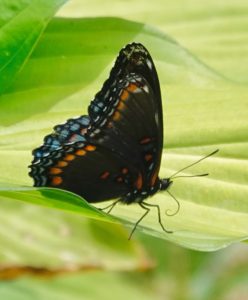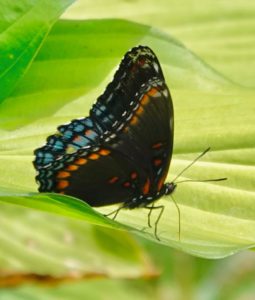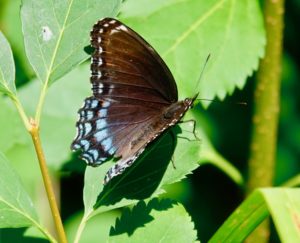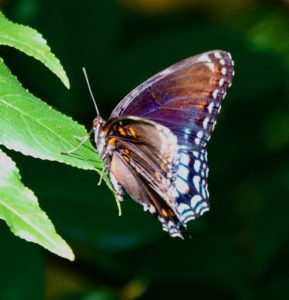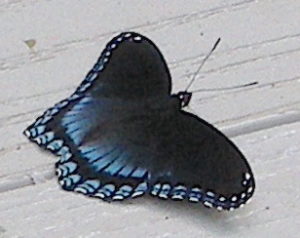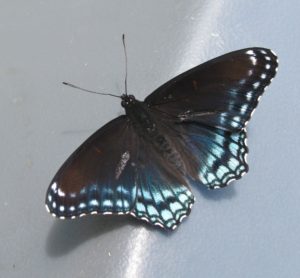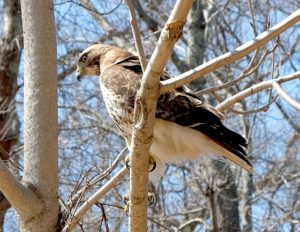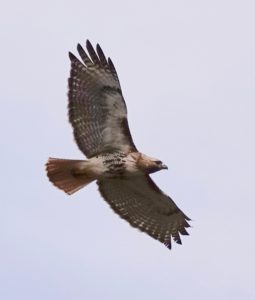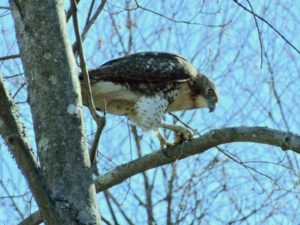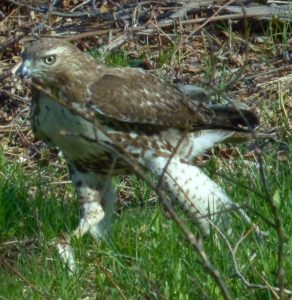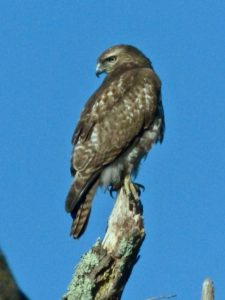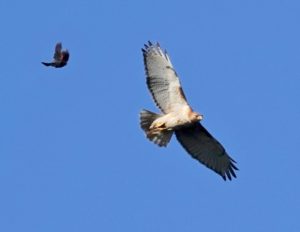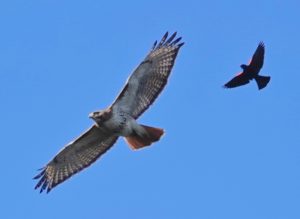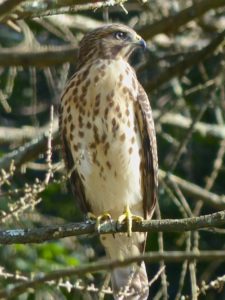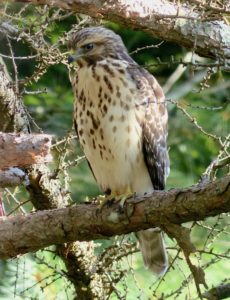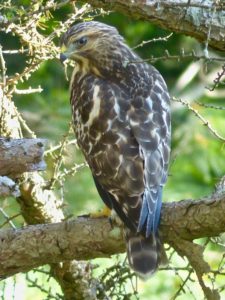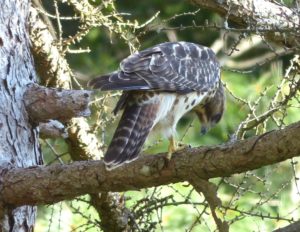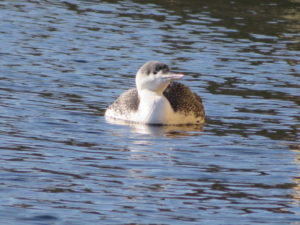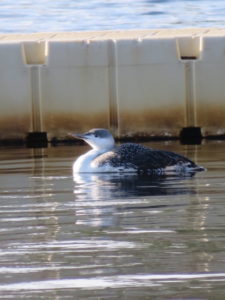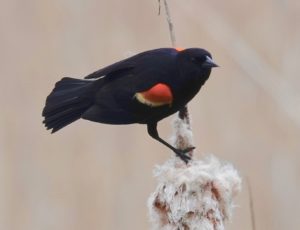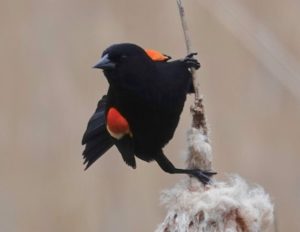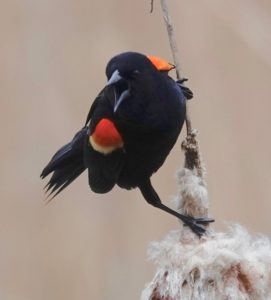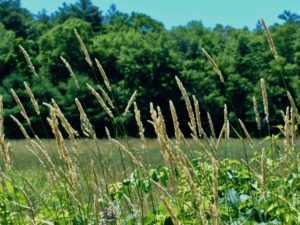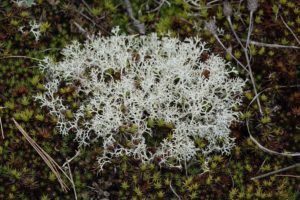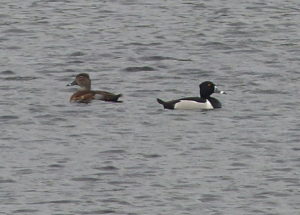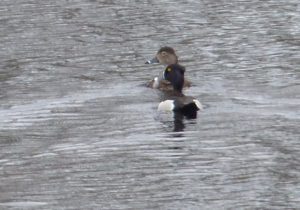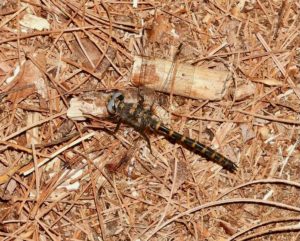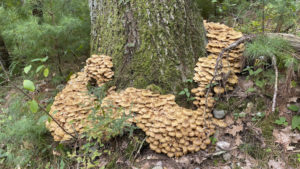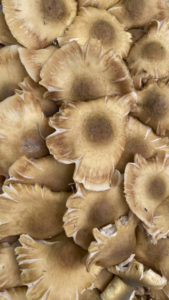Sightings grid
Observer: Susan Drisko
Observation Date: 4/27/2022
Observation Time: 3:25 p.m.
Observation Location: Town-owned conservation land near Moose Hill Audubon Wildlife Sanctuary
Common Name: Red Trillium
Scientific Name: Trillium erectum
Comments: Native to eastern North America, the red trillium (Trillium erectum) is found on forest floors. Its components surface in groups of three as pointed triple leaves, giving way to three-petalled flowers. Red trillium is mildly toxic to humans. The flowers smell like rotting meat so as to attract pollinating flies.
PLEASE DO NOT DIG UP WILD PLANTS.
More Information: Wikipedia
Observer: Paul Lauenstein
Observation Date: 4/10/10
Observation Time: 7:10 p.m.
Observation Location: Hockomock Swamp, Easton
Common Name: Red-backed salamander
Scientific Name: Plethodon cinereus
Comments: Red-backed salamanders can be found by turning over rotting logs in the woods.
More Information: Wikipedia
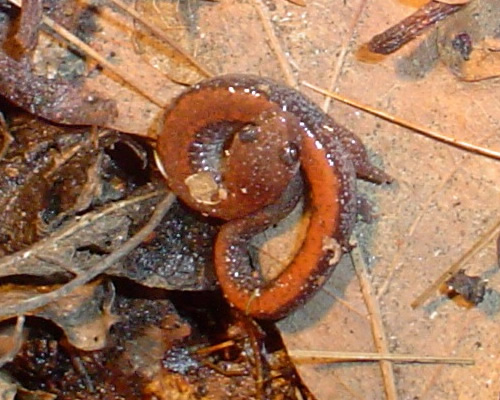
PS – Read about the salamander migration at Moose Hill in 2008.
Observer: Richard Kramer
Observation Date: 4/13/19
Observation TIme: midnight
Observation Location: Moose Hill Street near TTOR’s Moose Hill Farm
Common Name: Red-backed Salamander
Scientific Name: Plethodon cinereus
Comments: This photo was taken on “Big Night” – the first rainy night after the snow has melted in spring when a variety of woodland amphibians migrate from uplands down to nearby wetlands to spawn. To witness this amazing phenomenon, all you need is an umbrella and a flashlight. Walk carefully to avoid stepping on a frog or a salamander.
Red-backed salamanders can also be found by turning over rotting logs in the woods.
More Information: Wikipedia
Observer: Paul Lauenstein
Observation Date: 4/25/23
Observation TIme: 8:43 a.m.
Observation Location: Moose Hill Audubon Wildlife Sanctuary
Common Name: Red-backed Salamander
Scientific Name: Plethodon cinereus
Comments: Red-backed salamanders can be found by turning over rotting logs in the woods.
More Information: Wikipedia
Observer: Paul Lauenstein
Observation Date: 5/6/20
Observation TIme: 8:50 a.m.
Observation Location: conservation land near Lakeview & Morse
Common Name: Red-backed Salamander
Scientific Name: Plethodon cinereus
Comments: Red-backed salamanders can be found by turning over rotting logs in the woods.
More Information: Wikipedia
Observer: Paul Lauenstein
Observation Date: 9/9/13
Observation Time: 2:35 p.m.
Observation Location: Gavins Pond area
Common Name: Red-banded Sand Wasp
Scientific Name: Ammophila sabulosa
Comments: The female red-banded sand wasp first excavates a nest for her larva. After that she hunts a caterpillar, often a moth caterpillar. She then paralyses the caterpillar, but the caterpillar remains alive. Then she carries the caterpillar to the nest. She deposits an egg on the caterpillar. The larva of the wasp develops rapidly. It reaches full size after just 10 days. (Source: Jiri Zahradnik “Bees and Wasps”)
More Information: Wasps
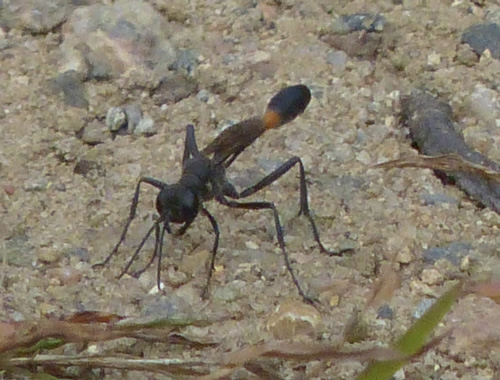
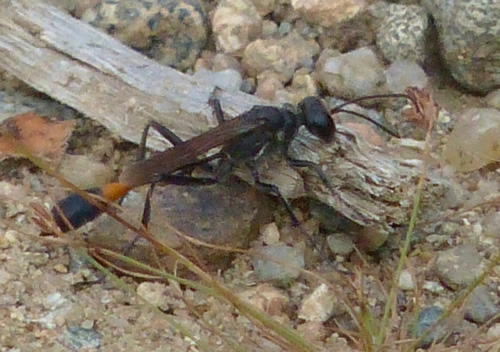
Observer: Josh Simons
Observation Date: 2/9/11
Observation Time: 10:00 a.m.
Observation Location: Moose Hill area
Common Name: Red-bellied Woodpecker
Scientific Name: Melanerpes carolinus
Comments: These birds have extended their breeding range north over the last 100 years.
More Information: All About Birds
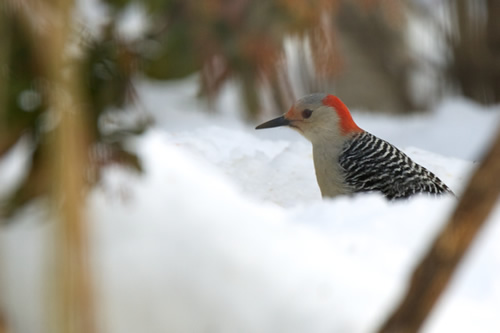
Observer: Paul Lauenstein
Observation Date: 3/8/14
Observation Time: 11:10 a.m.
Observation Location: Moose Hill Audubon Wildlife Sanctuary
Common Name: Red-bellied Woodpecker
Scientific Name: Melanerpes carolinus
Comments: Red-bellied woodpeckers are often victims of European starlings. As many as half of all red-bellied woodpecker nests in some areas get invaded by starlings.
More Information: Cornell Lab of Ornithology “All About Birds”
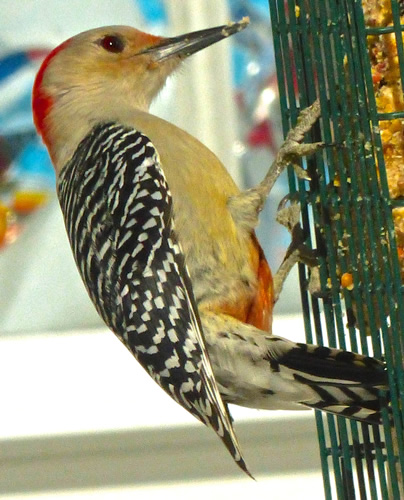
Observer: Paul Lauenstein
Observation Date: 5/13/16
Observation Time: 9:35 a.m.
Observation Location: Moose Hill Audubon Wildlife Sanctuary
Common Name: Red-bellied Woodpecker
Scientific Name: Melanerpes carolinus
Comments: Primarily a bird of the southeast, where its rolling calls are familiar sounds in swamps and riverside woods. Omnivorous and adaptable, this woodpecker has also adjusted to life in suburbs and city parks, and in recent years it has been expanding its range to the north. Despite the name, the faint traces of red on the belly are not often visible in the field.
Red-bellied woodpeckers are often victims of European starlings. As many as half of all red-bellied woodpecker nests in some areas get invaded by starlings.
More Information: Cornell Lab of Ornithology “All About Birds”
Observer: Josh Simons
Observation Date: 5/21/20
Observation Time: 6:30 p.m.
Observation Location: Moose Hill area
Common Name: Red-bellied woodpecker
Scientific Name: Melanerpes carolinus
Comments: Massachusetts is at the northern edge of the range for this species (as implied by its scientific name, Melanerpes carolinus), but they are becoming more common around here as a result of the warming climate.
Red-bellied woodpeckers make a very distinctivekwirr call. Learn to recognize it, and you will notice them often around Sharon.
More Information: All About Birds
Observer: Paul Lauenstein
Observation Date: 5/8/19
Observation Time: 10:20 a.m.
Observation Location: Moose Hill Audubon Wildlife Sanctuary
Common Name: Red-bellied woodpecker
Scientific Name: Melanerpes carolinus
Comments: I kept hearing their distinctive kwirr call in a certain area, so I investigated. When I finally spotted them, I saw they were nesting in a cavity high in a dead tree.
Sharon is at the northern edge of the red-bellied woodpecker’s range. It is a year-round resident.
More Information: All About Birds
Observer: Deborah Radovsky
Observation Date: 12/3/18
Observation Time: 9:10 a.m.
Observation Location: on trail in woods, near Sharon dog park
Common Name: Red-breasted Nuthatch
Scientific Name: Sitta canadensis
Comments: There have been flocks of these for weeks in these woods, more than I have ever observed over many years, possibly due to plentiful food sources. Note that the population of red-breasted nuthatches is shifting northward, according to the National Audubon Society. See: http://climate.audubon.org/birds/rebnut/red-breasted-nuthatch
More Information: All About Birds
Observer: Josh Simons
Observation Date: 2/24/13
Observation Time: 3:00 p.m.
Observation Location: Moose Hill area
Common Name: Red-breasted Nuthatch
Scientific Name: Sitta canadensis
Comments: Small photo due to heavy cropping.
More Information: All About Birds
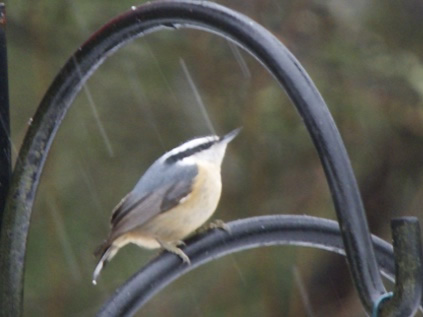
Observer: Paul Lauenstein
Observation Date: 5/6/18
Observation Time: 6:00 p.m.
Observation Location: Moose Hill Audubon Wildlife Sanctuary
Common Name: Red-breasted Nuthatch
Scientific Name: Sitta canadensis
Comments: This red-breasted nuthatch was visiting the bird feeder.
More Information: All About Birds
Observer: Paul Lauenstein
Observation Date: 5/29/14
Observation Time: 10:00 a.m.
Observation Location: King Phillip’s Rock trail
Common Name: Red-eyed vireo
Scientific Name: Vireo olivaceus
Comments: Red-eyed vireos sing all day long. Their song sounds like “Here I am. Where are you?” That is fitting, as they are very hard to see in the foliage.
More Information: All About Birds
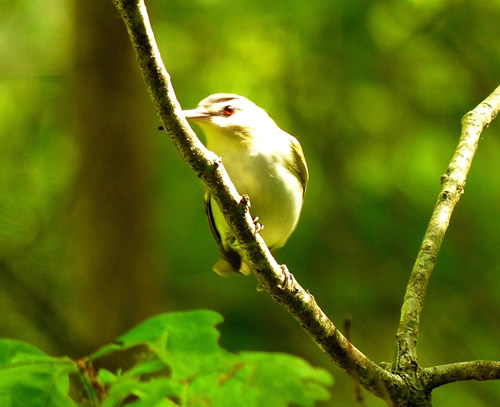
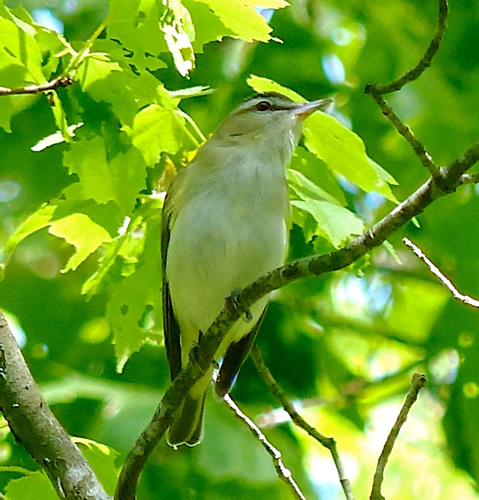
Observer: Paul Lauenstein
Observation Date: 5/30/20
Observation Time: 1:40 p.m.
Observation Location: Moose Hill Farm (TTOR)
Common Name: Red-eyed Vireo
Scientific Name: Vireo olivaceus
Comments: Red-eyed vireos are a common summer resident in Sharon. They sing all day long. Since they are notoriously hard to spot in the canopy, the mnemonic for their song is, “Here I am. Where are you?” Hear a recording at: https://www.allaboutbirds.org/guide/Red-eyed_Vireo/sounds. Note that all vireo species’ songs have a similar cadence.
More Information: All About Birds
This pair of red-eyed vireos was gathering nesting materials and building a nest:
Observer: Paul Lauenstein
Observation Date: 7/5/16
Observation Time: 10:40 a.m.
Observation Location: Moose Hill Audubon Wildlife Sanctuary
Common Name: Red-eyed Vireo
Scientific Name: Vireo olivaceus
Comments: Red-eyed vireos are a common summer resident in Sharon. They sing all day long. Since they are notoriously hard to spot in the canopy, the mnemonic for their song is, “Here I am. Where are you?” Hear a recording at: https://www.allaboutbirds.org/guide/Red-eyed_Vireo/sounds
More Information: All About Birds
Observer: Paul Lauenstein
Observation Date: 8/26/23
Observation Time: 4:10 p.m.
Observation Location: my back yard (Gavins Pond Road)
Common Name: Red-headed Bush Cricket (a.k.a. Handsome Trig)
Scientific Name: Phyllopalpus pulchellus
Comments: I had never seen one of these before I spotted this one on the wall of my house, but apparently they are pretty common. It has really long antennae and strange-lloking mouth parts that look a little like boxing gloves.
More Information: Jungle Dragon and Bug Eric
Observer: Paul Lauenstein
Observation Date: 1/25/24
Observation Time: 11:15 a.m.
Observation Location: Gavins Pond Rd.
Common Name: Red-shouldered Hawk
Scientific Name: Buteo lineatus
Comments: I was on a phone call when this juvenile red-shouldered hawk swooped in and landed just outside my window. I grabbed my camera with my free hand and snapped this photo.
More Information: All About Birds
Observer: Richard Kramer
Observation Date: 2/11/19
Observation Time: 10:30 a.m.
Observation Location: west side of Lake Massapoag near the Atlantic White Cedar Swamp
Common Name: Red-shouldered Hawk
Scientific Name: Buteo lineatus
Comments: One of the best ways to find Red-shouldered Hawks is to learn their distinctive whistle. Listen for these birds in and around wet forests, where you may find them hunting from a perch along stream or pond.
More Information: All About Birds
Observer: Will Sweet
Observation Date: 2/18/09
Observation Time: 11:45 a.m.
Observation Location: Sharon Community Gardens
Common Name: Red-shouldered hawk
Scientific Name: Buteo lineatus
Comments: The hawk was perched in a large dead tree. It flew across the gardens many times spooking robins and starlings.
More Information: Whatbird.com: Red-shouldered Hawk
Observer: Paul Lauenstein
Observation Date: 3/9/14
Observation Time: 2:40 p.m.
Observation Location: 4 Gavins Pond Road
Common Name: Red-shouldered hawk
Scientific Name: Buteo lineatus
Comments: As I sat at my desk talking on the phone, this hawk swooped in and landed on a branch outside my window. I grabbed my camera with my free hand and snapped this shot. I got help with the identification from my friend John Baur.
More Information: All About Birds
Observer: Deb Radovsky
Observation Date: 4/9/18
Observation Time: evening
Observation Location: Cottage and Ames Streets
Common Name: Red-shouldered Hawk
Scientific Name: Buteo lineatus
Comments: Although the American Crow often mobs the Red-shouldered Hawk, sometimes the relationship is not so one-sided. They may chase each other and try to steal food from each other. They may also both attack a Great Horned Owl and join forces to chase the owl out of the hawk’s territory.
More Information: All About Birds
Observer: Andrea & Herb Daroff
Observation Date: 5/15/08
Observation Time: 11:00 a.m.
Observation Location: Pilgrim Drive
Common Name: Red-shouldered hawk
Scientific Name: Buteo lineatus
Comments: This young hawk settled in a branch not more than 20 feet from our deck. I was able to get a number of shots and since he moved around a bit before flying away, I was able to shoot from different angles. We have seen him again in the yard but never again has he perched so conveniently, so cooperatively or so close.
More Information: Whatbird.com: Red-shouldered Hawk
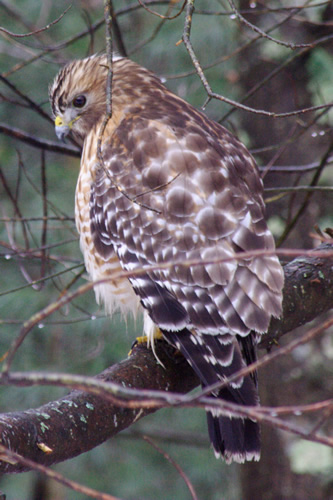
Observer: Josh Simons
Observation Date: 6/14/20
Observation Time: 4:00 p.m.
Observation Location: Moose Hill area
Common Name: Red-spotted Admiral (or red-spotted purple) butterfly
Scientific Name: Limenitis arthemis astyanax
Comments:
The red-spotted purple butterfly is the same species as the white admiral butterfly. It is a North American species in the genus Limenitis. It has been studied for its evolution of mimicry, and for the several stable hybrid wing patterns within this nominal species; it is one of the most dramatic examples of hybridization between non-mimetic and mimetic populations.
L. arthemis can be split into two major groups, mainly based on one physical characteristic: the presence or absence of a white band along the wings. Individuals of the northern group, called white admirals, have a conspicuous white band that traverse both the dorsal and ventral surfaces of the wing, while those of the southern group, called red-spotted purples, lack that trait as they have evolved to mimic the poisonous pipevine swallowtail (Battus philenor). Due to overlap in distribution among the two major groups, subspecies are numerous as hybridization occurs frequently.
More Information: Wikipedia
Observer: Paul Lauenstein
Observation Date: 6/10/23
Observation Time: 11:40 a.m.
Observation Location: Gavins Pond Rd. (my back yard)
Common Name: Red-spotted Admiral (or red-spotted purple) butterfly
Scientific Name: Limenitis arthemis astyanax
Comments:
The red-spotted purple butterfly is the same species as the white admiral butterfly. It is a North American species in the genus Limenitis. It has been studied for its evolution of mimicry, and for the several stable hybrid wing patterns within this nominal species; it is one of the most dramatic examples of hybridization between non-mimetic and mimetic populations.
L. arthemis can be split into two major groups, mainly based on one physical characteristic: the presence or absence of a white band along the wings. Individuals of the northern group, called white admirals, have a conspicuous white band that traverse both the dorsal and ventral surfaces of the wing, while those of the southern group, called red-spotted purples, lack that trait as they have evolved to mimic the poisonous pipevine swallowtail (Battus philenor). Due to overlap in distribution among the two major groups, subspecies are numerous as hybridization occurs frequently.
More Information: Wikipedia
Observer: Paul Lauenstein
Observation Date: 8/11/23
Observation Time: 10:30 a.m.
Observation Location: Gavins Pond Rd. (my back yard)
Common Name: Red-spotted Admiral butterfly
Scientific Name: Limenitis arthemis astyanax
Comments:
The red-spotted purple butterfly is the same species as the white admiral butterfly. It is a North American species in the genus Limenitis. It has been studied for its evolution of mimicry, and for the several stable hybrid wing patterns within this nominal species; it is one of the most dramatic examples of hybridization between non-mimetic and mimetic populations.
L. arthemis can be split into two major groups, mainly based on one physical characteristic: the presence or absence of a white band along the wings. Individuals of the northern group, called white admirals, have a conspicuous white band that traverse both the dorsal and ventral surfaces of the wing, while those of the southern group, called red-spotted purples, lack that trait as they have evolved to mimic the poisonous pipevine swallowtail (Battus philenor). Due to overlap in distribution among the two major groups, subspecies are numerous as hybridization occurs frequently.
Both the White Admiral and the Red-spotted Admiral have been sighted here in Sharon.
More Information: Wikipedia
Observer: Marshall Katler
Observation Date: 7/25/23
Observation Time: 12:30 p.m.
Observation Location: Mansfield St.
Common Name: Red-spotted Purple butterfly
Scientific Name: Limenitis arthemis
Comments: This butterfly was on this ramp to a shed for several hours, just opening and closing its wings, occasionally taking a short flight.
The red-spotted purple butterfly is the same species as the white admiral butterfly. It is a North American species in the cosmopolitan genus Limenitis. It has been studied for its evolution of mimicry, and for the several stable hybrid wing patterns within this nominal species; it is one of the most dramatic examples of hybridization between non-mimetic and mimetic populations.
L. arthemis can be split into two major groups, mainly based on one physical characteristic: the presence or absence of a white band along the wings. Individuals of the northern group, called white admirals, have a conspicuous white band that traverse both the dorsal and ventral surfaces of the wing, while those of the southern group, called red-spotted purples, lack that trait as they have evolved to mimic the poisonous pipevine swallowtail (Battus philenor). Due to overlap in distribution among the two major groups, subspecies are numerous as hybridization occurs frequently.
More Information: Wikipedia
Observer: Paul Lauenstein
Observation Date: 5/24/12
Observation Time: 8:20 a.m.
Observation Location: Gavins Pond area
Common Name: Red-spotted Purple butterfly
Scientific Name: Limenitis arthemis astyanax
Comments:
The red-spotted purple butterfly is the same species as the white admiral butterfly. It is a North American species in the cosmopolitan genus Limenitis. It has been studied for its evolution of mimicry, and for the several stable hybrid wing patterns within this nominal species; it is one of the most dramatic examples of hybridization between non-mimetic and mimetic populations.
L. arthemis can be split into two major groups, mainly based on one physical characteristic: the presence or absence of a white band along the wings. Individuals of the northern group, called white admirals, have a conspicuous white band that traverse both the dorsal and ventral surfaces of the wing, while those of the southern group, called red-spotted purples, lack that trait as they have evolved to mimic the poisonous pipevine swallowtail (Battus philenor). Due to overlap in distribution among the two major groups, subspecies are numerous as hybridization occurs frequently.
More Information: Wikipedia
Observer: Paul Lauenstein
Observation Date: 6/5/11
Observation Time: 4:50 p.m.
Observation Location: Kendall estate, Moose Hill Street
Common Name: Red-spotted Purple butterfly
Scientific Name: Limenitis arthemis astyanax
Comments:
The red-spotted purple butterfly is the same species as the white admiral butterfly. It is a North American species in the cosmopolitan genus Limenitis. It has been studied for its evolution of mimicry, and for the several stable hybrid wing patterns within this nominal species; it is one of the most dramatic examples of hybridization between non-mimetic and mimetic populations.
L. arthemis can be split into two major groups, mainly based on one physical characteristic: the presence or absence of a white band along the wings. Individuals of the northern group, called white admirals, have a conspicuous white band that traverse both the dorsal and ventral surfaces of the wing, while those of the southern group, called red-spotted purples, lack that trait as they have evolved to mimic the poisonous pipevine swallowtail (Battus philenor). Due to overlap in distribution among the two major groups, subspecies are numerous as hybridization occurs frequently.
More Information: Wikipedia
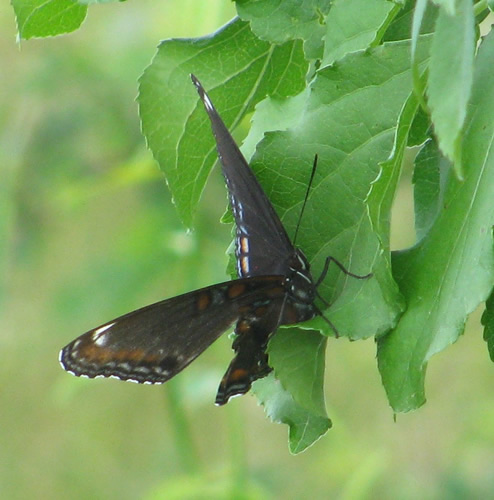
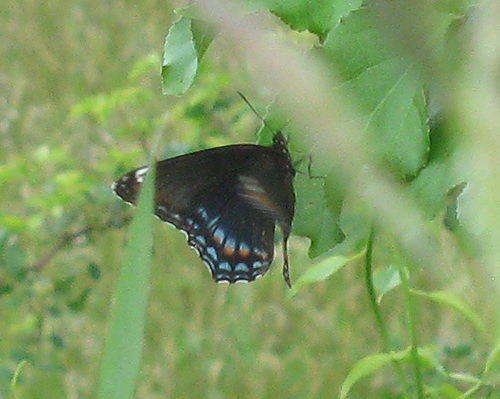
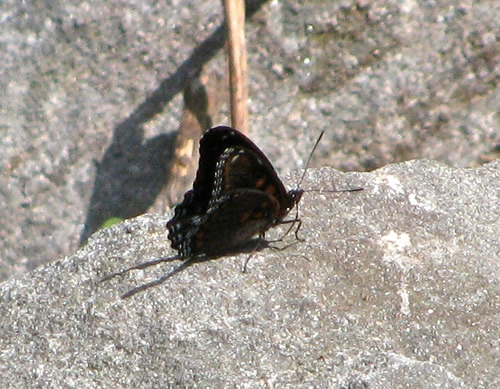
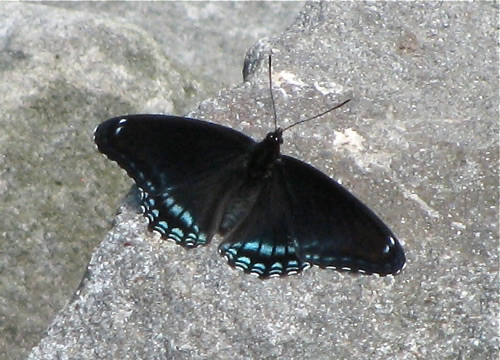
Observer: Faith Berkland
Observation Date: 6/6/15
Observation Time: 1:45 p.m.
Observation Location: 302 Mansfield Street
Common Name: Red-Spotted Purple butterfly
Scientific Name: limenitis arthemis
More Information: Butterflies and Moths of North America
Observer: Ilan Fisher
Observation Date: 4/3/19
Observation Time: 2:00 PM
Observation Location: Junction of E. Foxboro St. & Harding St.
Common Name: Red-tailed Hawk
Scientific Name: Buteo jamaicensis
Comments: Red-tails are big, but they only weigh a maximum of about 3 lbs. They can live up to 30 years. They feed predominantly on small mammals.
More Information: All About Birds
Observer: Paul Lauenstein
Observation Date: 5/11/20
Observation Time: 11:00 a.m.
Observation Location: near high-tension lines across the street from the Gavins Pond soccer fields
Common Name: Red-tailed Hawk
Scientific Name: Buteo jamaicensis
Comments: Red-tails are big, but they only weigh a maximum of about 3 lbs. They can live up to 30 years. They feed predominantly on small mammals.
More Information: All About Birds
Observer: Paul Lauenstein
Observation Date: 5/2/18
Obseration Time: 8:00 a.m.
Observation Location: Moose Hill Audubon Wildlife Sanctuary
Common Name: Red-tailed hawk
Scientific Name: Buteo jamaicensis
Comments: This red-tail had caught something – either a mouse or a frog. The hawk lost its grip on its prey, which dropped to the ground. The hawk immediately swooped down to the ground to retrieve its prize.
More information: All About Birds
Observer: Paul Lauenstein
Observation Date: 5/20/20
Observation Time: 4:26 p.m.
Observation Location: high tension lines opposite Ward’s Berry Farm
Common Name: Red-tailed Hawk
Scientific Name: Buteo jamaicensis
Comments: Red-tailed hawks are often harassed by songbirds. This one was engaged in a dogfight with a redwing blackbird.
More Information: All About Birds
Observer: Paul Lauenstein
Observation Date: 8/14/13
Observation Time: 7:00 a.m.
Observation Location: 4 Gavins Pond Road
Common Name: Red-tailed Hawk (juvenile)
Scientific Name: Buteo jamaicensis
Comments: Red-tails are big, but they only weigh a maximum of about 3 lbs. They can live up to 30 years. They feed predominantly on small mammals.
I took these photos out the kitchen window.
More Information: PBase
Observer: Deborah Radovsky
Observation Date: 12/3/18
Observation time: 9:30 a.m.
Observation Location: Lake Massapoag, swimming very close to shore
Common Name: Red-throated Loon
Scientific Name: Gavia stellata
Comments: Adult, non-breeding plummage. Breeds in the arctic.
More information: Wikipedia
Observer: Paul Lauenstein
Observation Date: 5/18/20
Observation Time: 8:45 a.m.
Observation Location: wetlands under high tension wires across the road from the Gavins Pond soccer fields
Common Name: Red-winged blackbird
Scientific Name: Agelaius phoeniceus
Comments: Red-winged blackbirds are typically found near water. Only the males have bright red epaulets on their wings
More Information: All about Birds
This is a female red-winged blackbird:
Observer: Josh Simons
Observation Date: 5/12/20
Observation Time: 6:00 p.m.
Observation Location: Moose Hill area
Common Name: Red-winged blackbird (female)
Scientific Name: Agelaius phoeniceus
Comments: Red-winged blackbirds are typically found near water. The males are black with bright red epaulets on their wings. The females are dramatically different. The bird in this photo is a female.
More Information: All about Birds
Observer: Paul Lauenstein
Observation Date: 8/11/10
Observation Time: 8:00 a.m.
Observation Location: Gavins Pond outflow pool
Common Name: Redfin Pickerel
Scientific Name: Esox americanus americanus
Comments: Redfin pickerel only reach a maximum of about a foot in length. They are typically much smaller—this specimen was only about 4″ long. They are common in Sharon’s streams. Preys on invertibrates and smaller fish.
More Information: Wikipedia
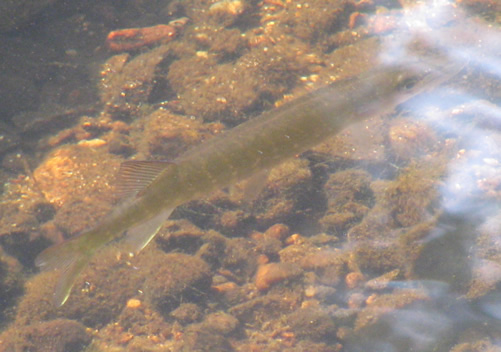
Observer: Paul Lauenstein
Observation Date: 3/1/11
Observation Time: 5:10 p.m.
Observation Location: near Gavins Pond
Common Name: Redwing blackbird
Scientific Name: Agelaius phoeniceus
Comments: First redwing I’ve seen this season. The ground is blanketed in old snow and the pond is still frozen solid. In fall and winter they eat weedy seeds such as ragweed and cocklebur as well as native sunflowers and waste grains.
More Information: All about Birds
Observer: Paul Lauenstein
Observation Date: 5/15/14
Observation Time: 5:10 p.m.
Observation Location: Gavins Pond Road
Common Name: Redwing blackbird
Scientific Name: Agelaius phoeniceus
Comments: Redwing blackbirds are typically found near water.
More Information: All about Birds
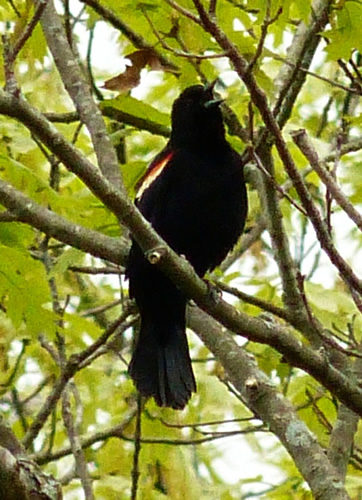
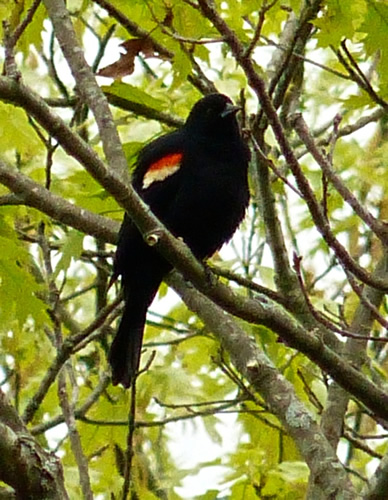
Observer: Paul Lauenstein
Observation Date: 7/7/18
Observation Time: 12:50 p.m.
Observation Location: Moose Hill Farm (TTOR)
Common Name: Reed Canary Grass
Scientific Name: Phalaris arundinacea
Comments: Reed canary grass has become invasive or problematic in New England and across North America, and the invasive plants may be the Eurasian genotype.
More Information: GoBotany
Observer: Paul Lauenstein
Observation Date: 5/18/20
Observation Time: 10:20 a.m.
Observation Location: under high tension lines across the street from the Gavins Pond soccer fields
Common Name: Reindeer lichen
Scientific Name: Cladonia rangiferina
Comments: Reindeer lichen is a light-colored, fruticose lichen belonging to the family Cladoniaceae. It grows in both hot and cold climates in well-drained, open environments. As the common names suggest, reindeer lichen is an important food for reindeer (caribou) and has economic importance as a result. Reindeer lichen, like many lichens, is slow growing (3–11 mm per year) and may take decades to return once overgrazed, burned, trampled, or otherwise consumed.
More Information: Wilipedia
Observer: Paul Lauenstein
Observation Date: 3/19/09
Observation Time: 4:00 p.m.
Observation Location: Gavin’s Pond
Common Name: Ring-necked Duck
Scientific Name: Aythya collaris
Comments: I saw ring-necked ducks last spring at Gavins Pond. They must use Gavins Pond to rest and feed during their migration.
More Information: All About Birds: Ring-necked Duck
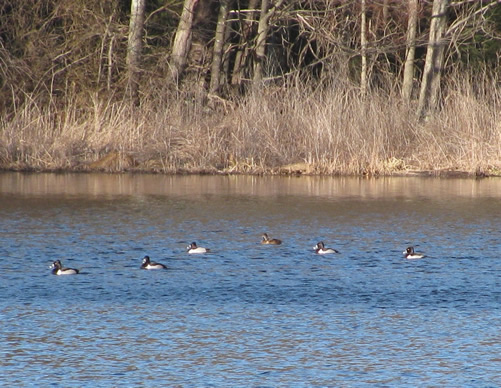
Observer: Paul Lauenstein
Observation Date: 3/25/11
Observation Time: 5:20 p.m.
Observation Location: Gavin’s Pond
Common Name: Ring-necked Duck
Scientific Name: Aythya collaris
Comments: Ring-necked ducks migrate through Sharon, and can be seen in spring and fall.
More Information: All About Birds: Ring-necked Duck
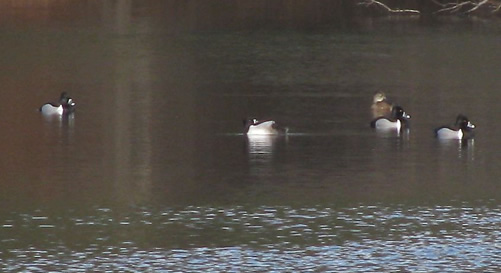
Observer: Paul Lauenstein
Observation Date: 4/18/13
Observation Time: 2:20 p.m.
Observation Location: Gavin’s Pond
Common Name: Ring-necked Duck
Scientific Name: Aythya collaris
Comments: Ring-necked ducks migrate through Sharon, and can be seen in spring and fall.
More Information: All About Birds: Ring-necked Duck
Observer: John Baur
Observation Date: 5/10/23
Observation Time: 12:04 p.m.
Observation Location: Moose Hill Farm (TTOR). The exact location can be seen here: https://www.inaturalist.org/observations/160951954
Common Name: Ringed Boghaunter dragonfly
Scientific Name: Williamsonia lintneri
Comments: The aquatic nymphs of the ringed boghaunter lives underwater for over a year. In late April to early May they are one of the first dragonflies to emerge from the water as a winged adult. Adults spend most of their time in woodlands basking in the sun and looking for small insects on which to feed.
More Information: Mass.gov
Observer: Josh Simons
Observation Date: 9/17/20
Observation Time: 3:00 p.m.
Observation Location: Moose Hill area
Common Name: Ringless Honey Mushroom
Scientific Name: Armillaria tabescens
Comments: These ringless mushrooms extended almost all the way around the tree.
WARNING: This is NOT a beginner’s mushroom. Never eat any wild plant unless you are 100% sure that you have identified an edible species.
More Information: The Foraged Foodie
Observer: Pat Gardner
Observation Date: 11/11/12
Observation Time: 6:15 a.m.
Observation Location: Shepard’s Pond, Canton
Common Name: River Otter
Scientific Name: Lontra canadensis
Comments: This morning there was only one, but over the past 2 months there’ve been 2. Shepard’s Pond is on the Canton-Sharon border.
More Information: Massachusetts Division of Fisheries and Wildlife

